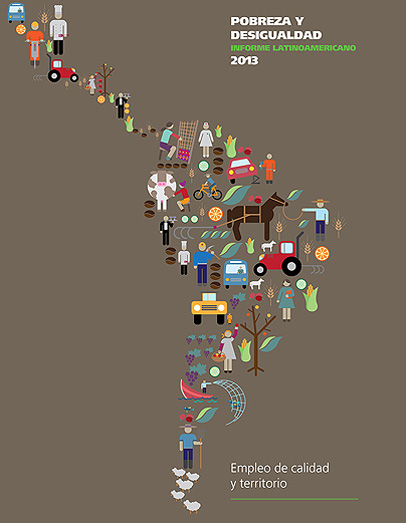Latin American Report on Poverty and Inequality 2013
In the Latin American Report on Poverty and Inequality 2011, we noted that Rimisp – Latin American Centre for Rural Development – is in the camp of those who believe that regional inequalities, especially when they are of the magnitude we have seen in Latin America, are indeed a problem and an obstacle to development. Whilst we share the idea that in a world of perfect markets and, in the long term, a process of regional convergence such as that postulated by the World Bank (2009) should occur, there are a set of factors that in practice, within the next one or two generations, prevents or delays this convergence.
In the context of this new Report, we need to question the type of institutional reforms that need to be undertaken so that the possibilities of those who live in a given territory to access quality employment do not depend solely on the characteristics of the economic-productive structure. We highlight several areas of reform.
Reforms aimed at modifying the production structure of low-productivity sectors and territories, including policies to encourage and promote economic activity that help diversify the production structure or generate links between low- and high-productivity sectors; human capital development policies to improve workers’ skills in order to increase labour productivity; and policies to regulate and oversee compliance with current labour regulations. The gaps reported in Chapter 2 make it clear, for example, that investment in education and support for the development of non-primary productive sectors in lagging territories are policies that in the medium term can have an impact on improving their employment quality indicators.
Reforms in the design and implementation of public labour and social protection policies, so as to move away from the traditional approach, in which sectoral visions, programmes and budgets prevail, rather than comprehensive approaches to meet the needs of each territory. The invitation is to design and implement comprehensive development policies for the territories, which take full account of the diversity of territorial conditions and, consequently, offer different goods and services according to the specific conditions of the context in which they will be implemented.
A third set of reforms appeals to the need to increase the decision-making power of local governments (decentralisation) in a way that allows national policies to be better tailored to local needs, and complemented by specific responses to those needs. Several of the cases documented in Part Three of this Report are relatively successful in their particular conjunction of national policies with relevant and timely local responses to the possibilities opened up by the economic scenario at a given moment in time. The challenge is to make such responsiveness the norm rather than the exception.
Specific support policies are also required for the territories lagging furthest behind, in order to narrow the existing gaps both in the quality of employment and in other socio-economic indicators, as documented in Part One of this Report. As a basic starting point, it is necessary to have information systems that allow for regular reporting on the evolution of territorial gaps.
Another challenge for the region is to promote processes to encourage social dialogue in the search for agreements, from the promotion of labour standards that set minimum acceptable conditions, to the strengthening of collective bargaining and the elimination of anti-union practices. From a territorial perspective, it is essential that progress in national legislation and regulations in these areas is combined with territorial development policies that enable the social, political and institutional capacities of the territories to be strengthened, so that the social actors in the territories interact and build their forms of collective action in the way, at the pace and with the objectives that they themselves value and are capable of implementing.
Closing territorial gaps: better employment opportunities for people regardless of where they live.
Our offices:
- Chile: Huelén 10. Providencia, Santiago, Metropolitan Region. (+56-2) 2236 4557 | Fax (+56-2) 2236 4558.
- Ecuador: Czechoslovakia E9-95 between Switzerland and Moscow. Eveliza Plaza Building. First floor. Quito. (+593-2) 5150144.
- Colombia: Carrera 9 No 72-61 Office 303. Bogotá. (+57-1) 2073 850.

